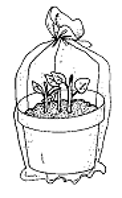Hydrangea
Hydrangea is a deciduous woody ornamental shrub or climbing plant that is known for its showy clusters of flowers that come in a large variety of colors including white, lime green, pink, purple, and blue. They are hardy to USDA zone 6 and some varieties are hardy to USDA zones 5 or 4 which makes them a popular shrub for New England landscapes.
Hydrangea Varieties
Clicking on the highlighted links will bring you to the UConn Plant Database information for each type.
Hydrangea anomala subsp. petiolaris or climbing hydrangea. This hydrangea is a climbing woody vine that is native to Asia. It has fragrant white lacecap blossoms and will tolerate full sun, partial shade, and full shade although there will be fewer flowers in full shade. It can be planted on the north or east-facing side of a building and has aerial roots that will cling to almost any sturdy structure or support. Bloom occurs in June and July. It takes 2-3 years to establish but can then grow up to 30’ tall and 8’ wide. Hardy to zone 4. Deer resistant.
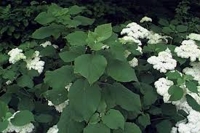 Hydrangea arborescens, or smooth hydrangea includes the ‘Annabelle’ and ‘Grandiflora’ varieties which can grow to 5’ tall and wide and have showy white, pink, or green umbellate corymbs that bloom from May to July. Often planted as a hedge. Hardy to zone 4 and can take partial shade.
Hydrangea arborescens, or smooth hydrangea includes the ‘Annabelle’ and ‘Grandiflora’ varieties which can grow to 5’ tall and wide and have showy white, pink, or green umbellate corymbs that bloom from May to July. Often planted as a hedge. Hardy to zone 4 and can take partial shade.
 Hydrangea macrophylla, known as the mophead or bigleaf hydrangea, is a common type of hydrangea grown in New England. These are the variety of hydrangea with large, rounded blue, purple, fuchsia, or pale pink snowball flower heads. Lacecap hydrangeas (Hydrangea macrophylla var. normalis) are a variety of bigleaf hydrangea that have corymbs of small fertile flowers that are surrounded by larger, showier sterile flowers. Hardy to zone 6.
Hydrangea macrophylla, known as the mophead or bigleaf hydrangea, is a common type of hydrangea grown in New England. These are the variety of hydrangea with large, rounded blue, purple, fuchsia, or pale pink snowball flower heads. Lacecap hydrangeas (Hydrangea macrophylla var. normalis) are a variety of bigleaf hydrangea that have corymbs of small fertile flowers that are surrounded by larger, showier sterile flowers. Hardy to zone 6.
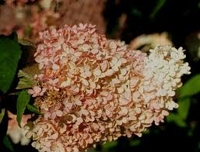 Hydrangea paniculata, panicle or PeeGee hydrangea. This North American native hydrangea has large, cone-shaped, panicle flower heads with strongly scented white, pink, or lime-green blossoms and is grown as a large shrub or small tree. It blooms mid-July to early-September. This variety prefers full sun to partial shade. Hardy to zone 3.
Hydrangea paniculata, panicle or PeeGee hydrangea. This North American native hydrangea has large, cone-shaped, panicle flower heads with strongly scented white, pink, or lime-green blossoms and is grown as a large shrub or small tree. It blooms mid-July to early-September. This variety prefers full sun to partial shade. Hardy to zone 3.
 Hydrangea quercifolia, or oakleaf hydrangea, has upright pyramidal clusters of white flowers. The leaves are shaped like an oak leaf and will turn red-purple in the fall. It can grow to 8’ tall. Hardy to zone 5 but flower bud injury is likely.
Hydrangea quercifolia, or oakleaf hydrangea, has upright pyramidal clusters of white flowers. The leaves are shaped like an oak leaf and will turn red-purple in the fall. It can grow to 8’ tall. Hardy to zone 5 but flower bud injury is likely.
Site Selection and Planting
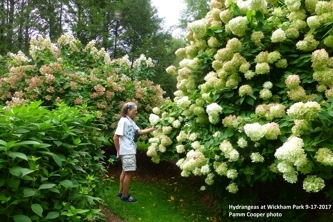
Site selection may be dependent on the variety. Climbing hydrangea may reach 30’ and will require sturdy support. Hydrangea arborescens, H. quercifolia, and H. paniculata can grow 8 to 10’ tall and are best used as backdrop or hedge plantings unless pruned to maintain height. Hydrangea macrophylla is the most common form used in landscape beds as it will grow 3 to 6’ tall.
All hydrangea should be planted in well-drained, fertile soil that has adequate amounts of organic matter. A soil test from the UConn Soil and Nutrient Analysis Lab is recommended before planting, especially if you are going to maintain the pink or blue blossoms of H. macrophylla.
All hydrangea require 6-8 hours of full sun per day for the most abundant blooms. Too much shade will reduce or eliminate flowering. Hydrangea are shade tolerant and even prefer afternoon shade in hot climates but heavy shade such as under a large tree or on the north side of a structure will not allow enough light for flowering. Oakleaf hydrangea does well in full sun or partial shade and is the best choice for hot climates. It will have more colorful foliage if it receives more sun
.
Visit our fact sheet Tree and Shrub Planting Guidelines for general information.
Water
Hydrangea require 1” of water per week during normal conditions and 2” per week during hot, dry weather. The use of soaker or drip hoses for one or two long soaks a week is recommended. Hydrangea that are allowed to wilt continually will be stressed and may produce fewer flower buds the following year. Do not water the foliage if possible to minimize leaf spot diseases. Continue to water hydrangea until the ground freezes.
Fertilization and Soil pH
A 5-10-10 slow-release fertilizer can be applied late spring and mid-summer but not after August 15th. Most hydrangea do well in a slightly acidic soil. It is this lower pH in the 4.0 to 5.0 range that makes aluminum ions in the soil available to Hydrangea macrophylla and gives them blue blossoms. In order to have pink blossoms the soil pH must be raised to 6.0-7.0 so that the aluminum ions are tied up in the alkaline soil. A soil test will provide the amendment information necessary to enact those changes.
If the soil pH is too high, hydrangeas may develop iron deficiency. This is indicated when younger leaves exhibit yellowing between the veins. If older leaves are yellowing, nitrogen deficiency is likely. A short term solution without lowering the soil pH is to add iron to the soil in the form of iron chelate. For a more long term solution, lower the soil pH using an aluminum sulfate or sulfur product. For either approach, follow product label instructions carefully.
Care and Maintenance
One of the most common issues with hydrangea is the failure to produce blooms. This is most often related to pruning practices or winter/frost injury. Flower buds may begin to break dormancy during a late winter or early spring warm period and subsequent freezing temperatures can kill them. To protect hydrangea that bloom on old wood from this problem, surround the plant with a cylindrical wire mesh enclosure and fill loosely with leaves or mulch. Add additional material as it settles. Remove mulch after the danger of a killing frost has passed.
Potted hydrangeas from florists are popular Easter and Mother’s Day gifts. Once the flowers fade and the danger of frost is past, it can be planted outside in a sheltered location. These hydrangeas (usually H. macrophylla) have been raised in greenhouses with an emphasis on producing luxuriant bloom and are not generally as winter hardy as nursery grown plants. The flower buds may not survive the winter. To boost the chances of successful overwintering try the following: around the July 4th, prune to 3 to 5 inches above the ground. The plant will produce new growth with dormant terminal flower buds. Before temperatures drop below 25° F, place a screen around the plant and fill will insulation such as coarse peat moss, vermiculite or bark mulch. Add additional material if it settles during the winter. Remove the protection when the crocuses flower in the spring but protect on cold nights.
The best time to transplant hydrangea is when they are dormant (after all leaves have been shed). Dig up as much of the root ball as possible. Water thoroughly after transplanting and then regularly during the first two summers. It is best to water deeply less often than to water daily.
Propagation
Stem Cuttings
- The best time to start stem cuttings is early summer.
- Remove a 5-6” cutting from a shoot that does not have a flower.
- Remove all but the top leaves.
- Cut larger to leaves to about half of their size (cut perpendicular to the mid-vein) to reduce the demands for water while the plant is rooting (see illustration on below left).
- Dip the cuttings in a rooting hormone and place them in a moist mixture of half peat or potting soil and half fine-grade perlite, vermiculite, or sand.
- Place about 2” of the cutting in the soil. Water the cuttings by misting with a spray bottle.
- Keep the soil moist but not soggy.
- A good way to retain moisture during the rooting process is to enclose the cuttings in plastic (see illustration on below right).
- Stakes can be used to prevent the plastic from touching the leaves.
- Place in a well-lit area away from direct sunlight and at 60-80°F.
- New growth should appear in about 2 weeks.
- Plants are ready to transplant after 4 weeks.
Ground Layering
- Ground layering consists of placing a branch still attached to the plant in the ground to encourage rooting.
- Select a branch close to the ground and remove all leaves from the part of the branch that will be buried.
- Scrape off a small amount of bark on the underside of the branch.
- Make sure there is at least one leaf node in the buried section because this is where roots develop best.
- Dig a trench the length of the leafless part of the branch and about 2” deep.
- Place the branch in the trench, cover thoroughly and water.
- A brick or stone on the newly watered soil will help retain moisture and keep the branch in place.
- Water occasionally and roots will form.
- Remove the rooted branch from the mother plant and transfer to a pot.
- If the new branch is cut off the mother plant (after roots form) and left in the ground undisturbed for a few more weeks transplanting may be more successful.
Preserving and Drying the Flowers
The most important factor in the success of drying hydrangea is the proper timing of harvest. Blooms will dry best if allowed to dry partially on the plant before they are picked. Try harvesting from August through October. As the flowers age, they will take on a vintage look. After cutting the blooms, strip off the leaves and arrange them in a vase and leave them to dry. They do not need to be hung upside down unless the stems are thin and weak.
Pruning
When pruning, cut back to just above a set of leaves.
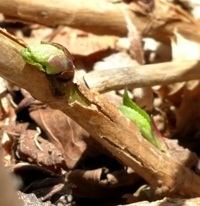
Each of the varieties of hydrangea should be pruned as follows:
| Variety | Blooms on old/new wood | When to prune |
| Hydrangea anomala subsp. petiolaris, or climbing hydrangea |
Blooms on old wood | Do not prune in the first 2-3 years as it establishes itself. Prune immediately following bloom period if shoots are growing beyond the desired area. |
| Hydrangea arborescens (Annabelle types) | Blooms on new wood (this year’s growth) | Prune in the fall, winter, or early spring. Pruning in early summer removes potential flower buds for the current season. ‘Annabelle’ (H. arborescens) is sometimes cut to within a few inches of the ground each fall or winter and when pruned this way they can be used as beautiful hedges. One problem that can result from this is that the young stems will not be stout enough to support the large flower heads (up to 10” across). To avoid this problem, prune back to 18-24” tall and allow the older stems to increase in diameter from year to year. |
| Hydrangea macrophylla, big-leaf hydrangea | Blooms on one-year-old wood | Prune in July as blooms start to fade but before flower buds are set for next year. Do not prune fall, winter, or early spring. Susceptible to winter or frost injury. |
| Hydrangea macrophylla, bigleaf hydrangea, ‘Endless Summer’ and ‘Let’s Dance’ cultivars | Bloom on old wood (last year’s growth) and new wood (this year’s growth) | Removing spent blooms will promote new blossoms. Prune in the spring. When these types of hydrangea are about 5 years old, remove about 1/3 of the stems down to the ground each summer after blooming to revitalize the plant |
| Hydrangea paniculata PeeGee’ types |
Blooms on new wood (this year’s growth) | Prune in the fall, winter, or early spring. Pruning in early summer removes potential flower buds for the current season. The ‘Pee Gee’ (H. paniculata) type hydrangeas can be pruned in fall, winter or spring. Annual pruning is not necessary except to trim out crisscrossed branches or dead wood. This type of hydrangea is the only kind that can be pruned into a tree form. When pruning, leave the trunk and the top branches. |
| Hydrangea quercifolia, oakleaf hydrangea |
Blooms on old wood | Prune in July as blooms start to fade but before flower buds are set for next year. Do not prune fall, winter, or early spring. When these types of hydrangea are about 5 years old, remove about 1/3 of the stems down to the ground each summer after blooming to revitalize the plant. |
Before and after pruning of H. paniculata
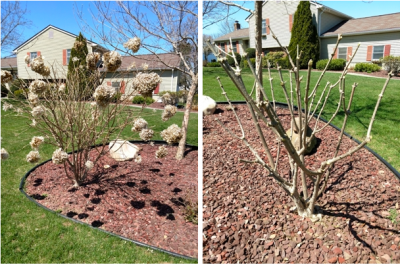
Diseases and Pests
Information and control options for diseases and insect pests of hydrangeas may be found at our Hydrangea Diseases and Pests fact sheet.
Despite good cultural practices, pests and diseases at times may appear. Chemical control should be used only after all other methods have failed. For pesticide information or other questions please call toll free: 877-486-6271.
UConn Home and Garden Education Center, 2018

